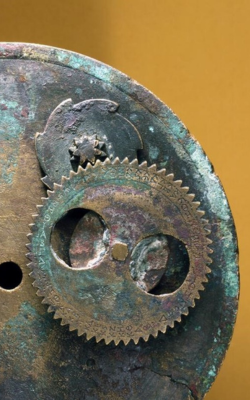Myths, legends and landings – our evolving relationship with the moon
Authors:
Dr Dominic Dalglish is a Postdoctoral Researcher in Classical Studies and Dr Stuart McKie is a Lecturer in Classical Studies at The Open University.
Ahead of launching a new exhibition as part of the annual European Lunar Symposium, which is being hosted by The Open University in Scotland, academics Dr Dominic Dalglish and Dr Stuart McKie explore our long and fascinating relationship with the moon.
What do we know about the moon? Humanity’s interest has never faltered, but there’s no doubting that in the last few years the moon has received renewed attention. Since 2020, various international and private agencies have launched 15 lunar missions, with 30 more planned before the end of the decade – more than double the total since the start of this century.
The scientific community will gather in Dumfries and Galloway this June for the 12th European Lunar Symposium, hosted by The Open University in Scotland, where the world’s leading experts will discuss the future of manned missions to the moon.
However, for most of history our appreciation of the moon has been from an Earth-bound perspective.
The moon is simultaneously mundane and magical – a routine fixture and an ever-inspiring surprise. In and around the ancient Mediterranean, we find some of the earliest recorded attempts both to measure its regular phases, and to account for – even exploit – the moon’s mysterious properties.
 Calendars are one of the moon’s most enduring gifts. The roughly 29.5 days that the moon takes to complete its phases provide us with units of ‘middle time’ – the week (quarter cycle) and month (full cycle) – between the solar day and year.
Calendars are one of the moon’s most enduring gifts. The roughly 29.5 days that the moon takes to complete its phases provide us with units of ‘middle time’ – the week (quarter cycle) and month (full cycle) – between the solar day and year.
A wonderfully preserved mechanism from a 5th or 6th century Byzantine sundial (pictured) allows you to calculate the phases of the moon against the solar year, bringing the two together.
From knowing when to prepare the harvest and manage livestock, right the way through to collecting debts on time, the moon has been in the background. For example, in the 4th century ‘Lunae Dies’ (Monday or ‘the Moon’s day’) was thought to be the best day to put manure on the fields or dig a well.
It raises the question why civilisations have believed the moon to be so powerful? As with many unknown forces of nature, people in the past attributed them to a divinity.
For the Egyptians, this was the god Khonsu, son of Mut (the Earth) and Amun (associated with the sun). In ancient Greece, the moon was represented by the goddess Selene (known as Luna in Roman mythology), whilst in parts of Anatolia (today part of Turkey) it was the god Mēn.
The powers attributed to the moon also vary between different parts of the world. In ancient Egypt, god Khonsu was associated with healing, whilst Mēn (pictured) was believed by some to be a weather god.
The moon has been a wonderful source of inspiration for myths and legends. In one of the best-known Greek myths, Selene was said to have fallen in love with the mortal Endymion, who according to some versions of the myth was an astronomer and the first person to observe the patterns of the moon.
 So taken with his beauty, the goddess caused him to fall into an eternal sleep so he would not age or die. They are said to have had 50 daughters together, collectively known as ‘the Menai’, who represented the 50 lunar months of the four-year Olympiad.
So taken with his beauty, the goddess caused him to fall into an eternal sleep so he would not age or die. They are said to have had 50 daughters together, collectively known as ‘the Menai’, who represented the 50 lunar months of the four-year Olympiad.
The stories of the moon have continued to be reimagined over time. The 2nd century Syrian-born satirist Lucian wrote in ‘True History’ of an adventure to the moon, where he fights on behalf of the King of the Moon Endymion against the Heliotans of the Sun, on a battlefield woven by giant spiders.
The work has been described as the world’s first science fiction.
These characters and stories continue to inspire modern culture today. Egyptian god of the moon Khonsu is the inspiration behind the Marvel comic character ‘Khonshu’, who gives powers to the superhero ‘Moon Knight’.
For modern pagans, witches and wiccans, the feminine framing of the moon – sometimes linked to the ancient Greek goddess Hecate – continues to be of significance.
As experts gather at the European Lunar Symposium in June to discuss when the first colony might grace the surface of the moon, it is still possible to look up with wonder and imagine gods and goddesses and magical forces.
The last century has transformed our understanding of the Earth’s celestial dance partner from a distant, somewhat abstract presence in our sky, to a tangible place. This signifies a new dimension in our already complex relationship with our moon.
The Open University (OU) is co-hosting the European Lunar Symposium in Dumfries and Galloway 16-21 June 2024, plus accompanying public Solstice Seminars on the evening of Thursday 20 June 2024.
Photo credits:
Moon-phase disk from a portable sundial-calendar © Science Museum
Statuette of the Phrygian god Mên © President and Fellows of Harvard College
11 June 2024
News

Scottish-led Trauma Support course, created with and for young people, launches UK-wide
A new training course is being rolled out to help better support children and young people affected by trauma.

Open University joint top in Scotland for student satisfaction
The OU in Scotland has been ranked joint first for overall student satisfaction amongst all universities in Scotland in the NSS 2025, published today.
Media contacts
Media enquiries
OU in Scotland Media Relations:
Call 0131 549 7932
OU UK Press Office:
Call 01908 654316
Out-of-hours:
07901 515 891
Visit our OU UK news site
Newsletter
Sign up for our quarterly e-newsletter, Open Outlook.
